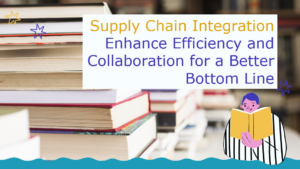Supply Chain Integration Enhance Efficiency and Collaboration for a Better Bottom Line
Supply chain integration represents a crucial strategy for modern businesses aiming to enhance efficiency, improve quality, and ultimately deliver superior value to their customers. This concept involves the seamless cooperation between buyers and sellers, ensuring that all parties benefit from the relationship. By fostering such partnerships, businesses can achieve improved quality, reliable delivery, and a better bottom line, while customers enjoy enhanced service and timely, dependable products.

What is Supply Chain Integration?
At its core, supply chain integration is about effective communication and collaboration between buyers and sellers. The primary goal is to establish a sustainable, cooperative relationship where the buyer’s needs are clearly understood and met by the supplier. This often involves the use of integrated computer systems that facilitate real-time data exchange. For instance, a supplier’s system might provide the buyer with up-to-date information on order status, inventory levels, production progress, shipment readiness, and tracking details. This transparency enhances the efficiency and reliability of the supply chain, exemplified by the experience of purchasing from online retailers where customers receive timely updates on their orders.
Two-Way Supply Chain Integration
Taking integration a step further, two-way communication between the buyer’s and seller’s systems can automate many processes. Buyers’ systems can monitor their own orders and production status and directly issue purchase orders to suppliers’ systems. This level of integration allows for a synergistic, automated flow of information, potentially triggering supplier production based on real-time demand without human intervention. Moreover, buyers’ systems might automatically check various suppliers for needed items, optimizing procurement to ensure timely delivery.
Complex Supply Chain Integration
Supply chain integration can extend to include a wide array of partners such as manufacturers, distributors, importers, consumers, banks, storage facilities, insurance companies, and transportation companies. The objective is to enhance efficiency and quality, eliminate waste, and reduce costs across the entire supply chain by fostering a collaborative environment. This comprehensive integration addresses common issues like high inventory costs, production inefficiencies, unreliable deliveries, and high transportation costs, resulting in a more streamlined and effective supply chain.
Supply Chain Integration: A Multi-Organization Structure
The purchasing department typically spearheads the integration process, starting with identifying supply chain issues and devising solutions. Goals are set, and a plan is formulated to improve the supply chain. This collaborative effort involves working closely with suppliers and vendors to implement necessary changes. Successful integration hinges on mutual benefits, requiring clear communication of the advantages to all parties involved. It’s a partnership where commitments are made by both sides to ensure shared success.
Elements of Supply Chain Integration
The successful implementation of supply chain integration relies on four key components, known as the Four C’s of Supply Chain Integration:
Communication: Essential for ensuring all parties are well-informed and able to adapt quickly to changes in demand and opportunities. Integrated computer systems and direct communication channels facilitate this process.
Customers: The focus should always be on meeting the final customer’s needs and preferences. This requires the lead organization to maintain close relationships with their customers and ensure that everyone in the supply chain understands their impact on customer satisfaction.
Collaboration: Effective integration requires strong relationships and collaborative efforts among all supply chain members. This might include joint product development and training initiatives to enhance product knowledge and market understanding.
Cooperation: Sharing critical supply and demand information, often considered proprietary, is vital for responsiveness to customer needs. This level of cooperation ensures that everyone in the supply chain can work towards common goals efficiently.
Benefits of Supply Chain Integration
Implementing supply chain integration yields numerous benefits:
– Flexibility: Enhanced ability to respond to market changes, supported by a shared commitment to quality and accuracy.
– Improved Inventory Management: Reduced overstock and understock situations, leading to lower storage costs and quicker replacement of obsolete items.
– Reduced Spending: Lower costs associated with quality control, inspections, administrative tasks, purchasing, and transportation.
– Improved Suppliers: Fewer, more reliable suppliers with better quality and delivery performance, fostering stronger supplier relationships.
Supply chain integration is a transformative approach that drives efficiency, quality, and cost savings across the supply chain. By focusing on communication, customer needs, collaboration, and cooperation, businesses can create robust, responsive supply chains that benefit all parties involved. Embracing this strategy ensures that companies not only meet but exceed customer expectations, securing a competitive advantage in today’s dynamic market.
